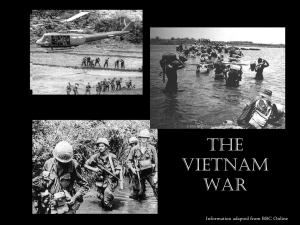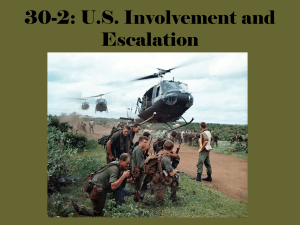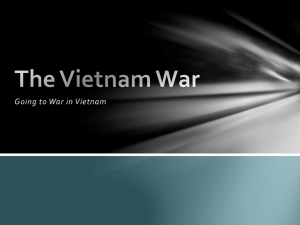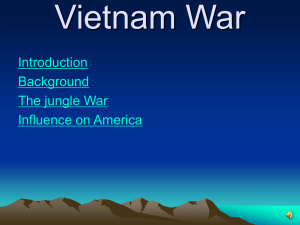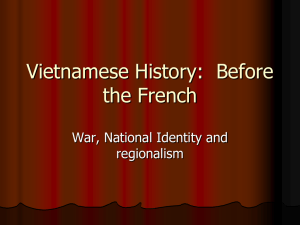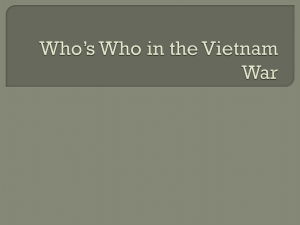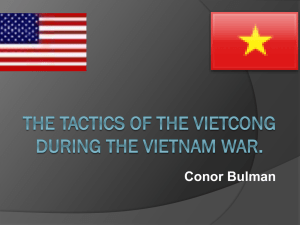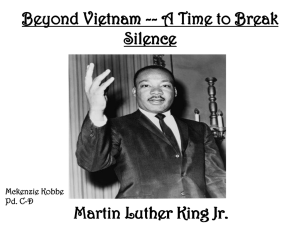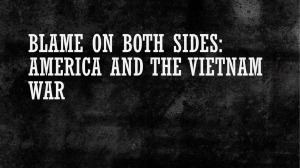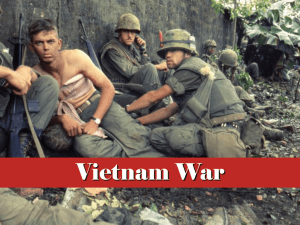AMH Chapter 19 Section 1 Part 3
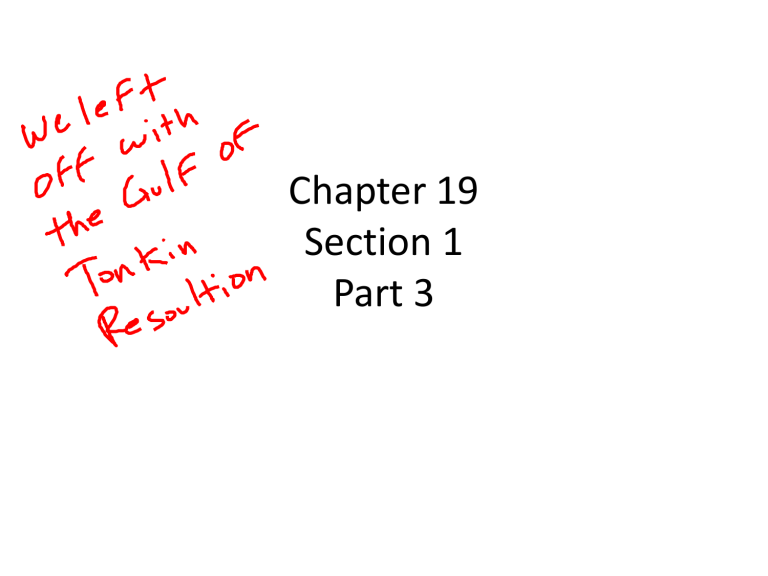
Chapter 19
Section 1
Part 3
After the Gulf of Tonkin Incident
• After the Gulf of Tonkin incident and Resolution in
August 1964, President
Johnson (in March 1965) ordered:
– American aircraft to begin a sustained bombing campaigned against targets in North Vietnam
– The first American combat troops into Vietnam.
Public Opinion
• In the spring of 1965, A
Gallup poll showed that
66% of Americans approved of the policy in Vietnam.
How the Vietcong fought
• When the American combat troops arrived in Vietnam, they discovered the guerilla tactics and fighting methods used by the
Vietcong which included ambushes and booby traps.
Vietcong Tactics
• The Vietcong blended into the civilian population and vanished after they struck their targets.
• American troops tried to find the enemy and bomb their positions, destroy their supply lines, and force them into the open.
“Search and Destroy”
• To counter the Vietcong’s ability to hide in thick jungles, American used
“search and destroy” missions.
• These mission included planes that dropped napalm, a jellied gasoline that explodes on contact.
• They also used Agent
Orange, a chemical that strips leaves from trees.
Continuous bombing
• American military leaders believed that continuous bombing and the killing of many
Vietcong would make them surrender.
• However, the guerrillas did not surrender.
Supply Chain
• North Vietnam received supplies from the Soviet
Union and China (both communist nations), and then sent supplies to South Vietnam through a network known as the Ho Chi
Minh trail.
Ho Chi Minh Trail
• The main North
Vietnamese supply route (known as the Ho
Chi Minh Trail) consisted of a network of jungle paths in
Cambodia and Laos, bypassing the border between North and
South Vietnam.
No…don’t invade North Vietnam
• President Johnson did not order an invasion of
North Vietnam because he feared this would bring China into the war.
• Instead of conquering enemy territory,
American troops tried to defeat the enemy by slowly wearing them down.
• As casualties on both sides mounted through
1967, the Vietcong still showed no sign of surrendering.
T.V. War
• Vietnam was the first
“television war”, with footage of combat appearing nightly on the evening news (along with the casualty count from fighting that day)
Credibility Gap
• Opposition to the
Vietnam War grew in the late 1960s.
• Many Americans believed a credibility gap had developed.
• Images of wounded and dead American soldiers in the media made
Americans doubt the government’s truthfulness about the war.
Containment of Vietnam
• George Keenan, the
American diplomat who helped to create the policy of containment believed that Vietnam was not strategically important.
Teach-ins
• Many college students began protesting the war.
• A group of faculty members and students at the University of
Michigan joined together in a teach-in to discuss opposition to the war.
Opposed to the war
• People opposed the war for different reasons.
Some believed it was a civil war that did not involve the United States.
• Others believed South Vietnam was a corrupt dictatorship, and supporting it was immoral.
• Some were against the draft system.
Postponing military service
• At the beginning of the war, college students were able to postpone military service until after they graduated.
Minorities in Vietnam
• Minorities, particularly
African Americans made up a disproportionately large number of soldiers in Vietnam.
• Other young people from low-income families were more likely to serve in the military because they could not afford college
MLK’s View
• In April 1967, Martin
Luther King Jr. broke his silence and publically condemned the conflict in Vietnam.
Two Sides
• Despite the antiwar protests, a majority of people in early 1968 supported the war.
• Those who wanted to withdraw from Vietnam were called doves.
• Those who wanted to stay and fight were called hawks.
Draft Lottery System
• In 1969 the government issued a lottery system for the draft.
• However, while men could be drafted to fight in Vietnam at age 18, they could not vote until they were 21.
26
th
Amendment
• Protests against the war and the draft led to ratification of the 26th amendment which gave citizens 18 years older the right to vote (the amendment was ratified in 1971).

